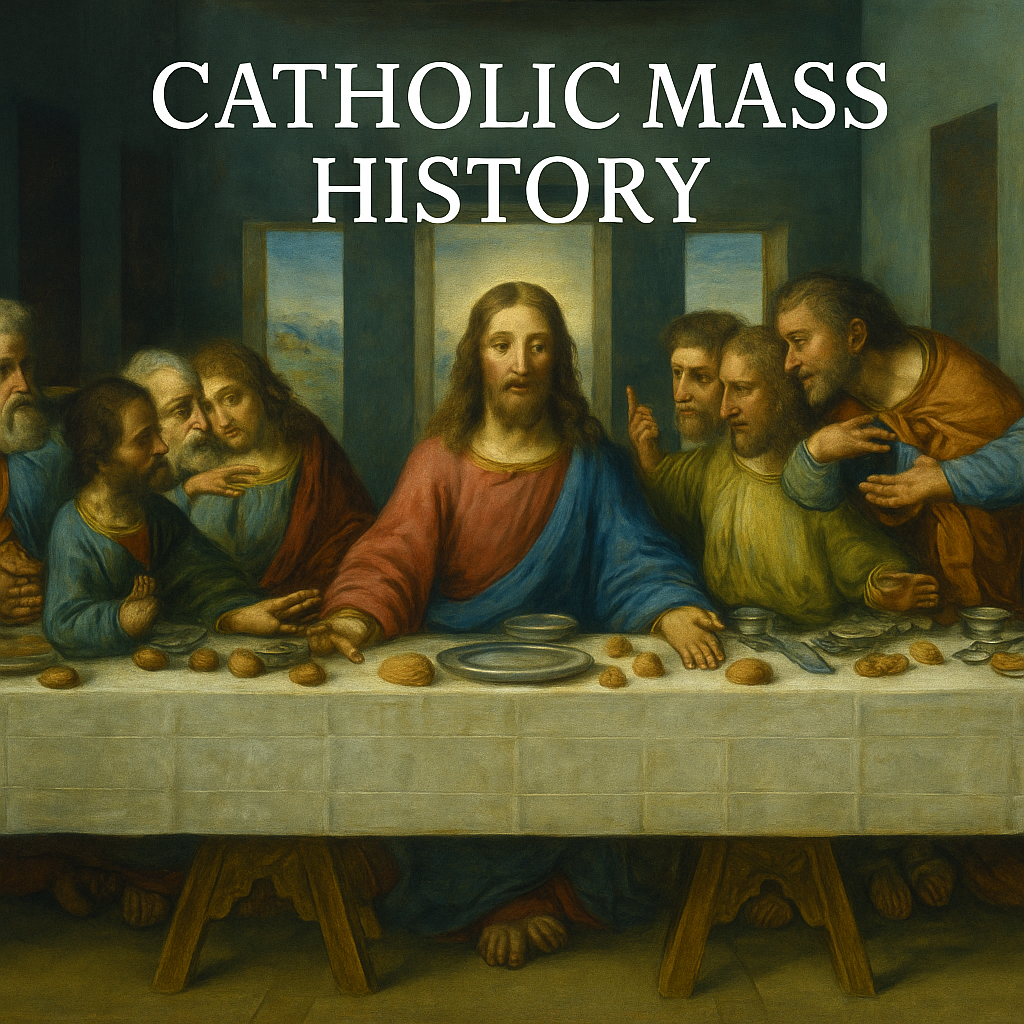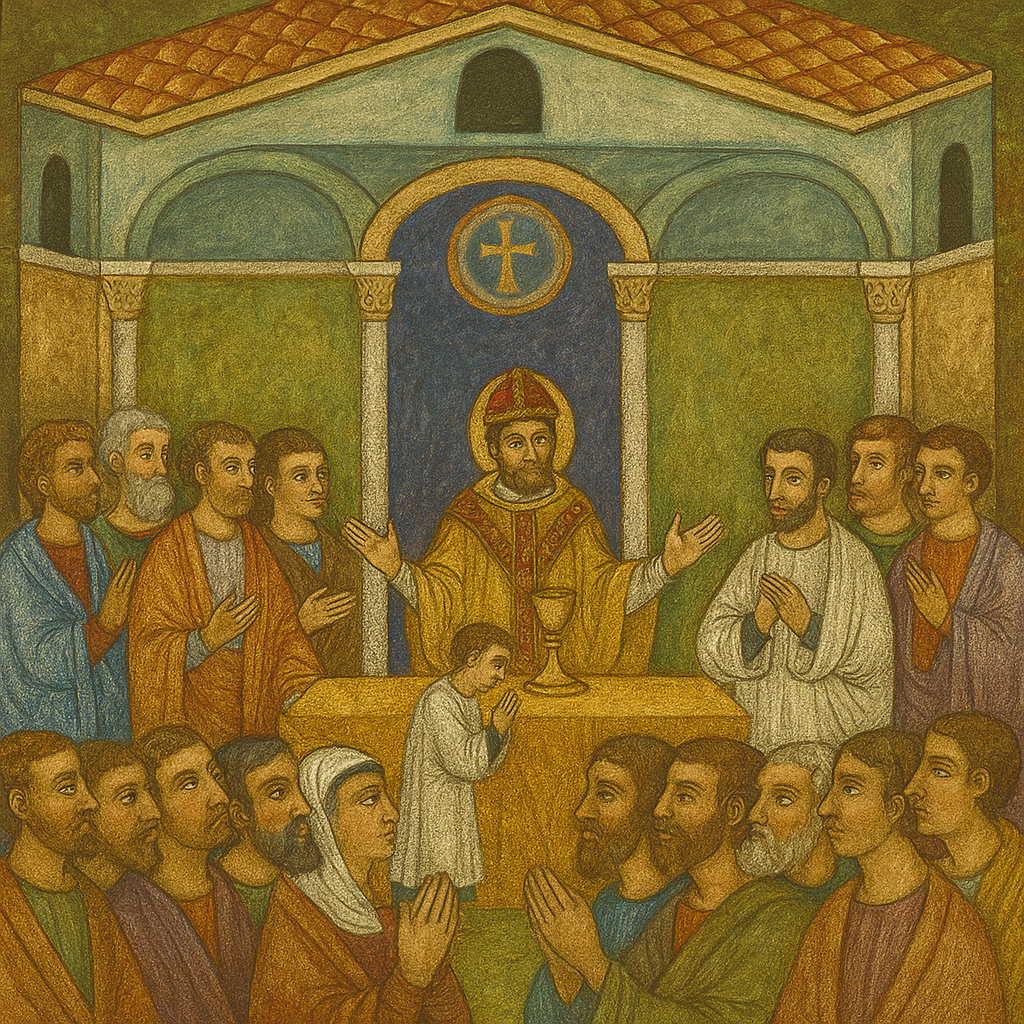Catholic Mass History: From the Upper Room to Today’s Liturgy

The history of the Catholic Mass spans over two thousand years, beginning with the Last Supper and continuing through every generation to the liturgy we celebrate today. As we explore Catholic Mass history, we see how the Church’s most sacred and central act has shaped Catholic identity, culture, and spiritual life through every age. While its external form has developed over time, the essence of the Mass has remained the same: the re-presentation of Christ’s sacrifice on Calvary, made present in the Holy Eucharist.
This article explores the remarkable evolution of the Catholic Mass history—from its biblical foundations to the Tridentine reforms and the post-Vatican II Novus Ordo—showing how the liturgy has developed while remaining rooted in the same mystery of faith.
The Biblical and Apostolic Origins of the Mass
The story of the Catholic Mass begins with Christ Himself. At the Last Supper, Jesus instituted the Eucharist, commanding His apostles to “Do this in memory of Me” (Luke 22:19). This moment, where bread and wine were consecrated into His Body and Blood, became the foundation of Christian worship. Early Christians, as seen in Acts 2:42, devoted themselves to “the breaking of the bread,” which was already understood as a sacred liturgical act.
In the first and second centuries, Masses were celebrated in house churches or catacombs due to Roman persecution. These early liturgies consisted of readings from Scripture, prayers, the kiss of peace, the Eucharistic Prayer, and communion—elements still recognizable in today’s liturgy. The structure of the Mass was in place even before formal buildings or vestments appeared.
The Rise of the Roman Rite and Latin in the Liturgy

As Christianity spread across the Roman Empire and eventually became legalized in the 4th century, the Church began celebrating the liturgy publicly in basilicas. Latin, which was the common language of the Western Church, became the normative liturgical language in Rome and most of Europe. This marked the rise of what we now call the Roman Rite—a liturgical tradition that emphasized reverence, structure, and universality.
By the 6th century, much of the Roman Canon (the central part of the Eucharistic Prayer) had already taken the form that would remain unchanged for over 1,400 years. Gregorian chant also emerged during this period as the Church’s primary form of sacred music, further elevating the sense of awe and worship.
The Council of Trent and the Codification of the Tridentine Mass
The 16th century was a time of upheaval, as the Protestant Reformation challenged core doctrines of the Catholic faith—including the Real Presence of Christ in the Eucharist. In response, the Church convened the Council of Trent (1545–1563), which reaffirmed Catholic teaching on the Mass and sought to ensure uniformity in liturgical practice.
As a result, Pope St. Pius V promulgated the Roman Missal of 1570, often referred to as the Tridentine Mass. This standardized form of the Mass was celebrated throughout the Latin Church with only minor regional variations for over 400 years. The Latin language, solemn rituals, ad orientem posture (priest facing the altar), and rich symbolism all expressed the Mass as a holy sacrifice rather than a communal meal.
The Tridentine Mass shaped the spiritual lives of countless saints and was considered one of the greatest artistic and theological achievements of Catholic tradition. Its structure emphasized reverence, silence, and transcendence—qualities that continued to inspire awe through the centuries.
The Liturgical Movement and the Road to Vatican II
By the late 19th and early 20th centuries, theologians, scholars, and clergy began to explore how the faithful could participate more actively in the liturgy. This movement, known as the Liturgical Movement, aimed to deepen the laity’s understanding of the Mass without changing its core theology or reverence.
Popes such as Pius X and Pius XII encouraged greater use of Gregorian chant and initiated modest reforms to improve participation, including restoring the Eucharistic fast and promoting frequent Communion. However, the central structure of the Tridentine Mass remained intact.
When the Second Vatican Council convened in 1962, it addressed the liturgy in its first major document: Sacrosanctum Concilium. This constitution affirmed the need for “full, conscious, and active participation” in the liturgy, encouraged the use of the vernacular alongside Latin, and called for a revision of the liturgical books to allow for “noble simplicity.”
The Creation of the Novus Ordo Missae
Following Vatican II, a commission of bishops and liturgical scholars, led by Archbishop Annibale Bugnini, reformed the Mass and published the Missal of 1970, commonly known as the Novus Ordo Missae (New Order of the Mass). This became the Ordinary Form of the Roman Rite and is the form of the Mass most Catholics attend today.
The Novus Ordo introduced several changes:
- Use of the vernacular (local languages) in place of Latin
- A greater number of Scripture readings through a three-year cycle
- The priest facing the people (versus populum) instead of the altar (ad orientem)
- Options for various Eucharistic Prayers and liturgical elements
- Increased lay involvement in readings, music, and liturgical ministries
The intention was to preserve the core of the Mass while making it more accessible and participatory. While warmly received by many, others expressed concern about a perceived loss of reverence and continuity with tradition. Nevertheless, the Church affirms the validity and dignity of both the Novus Ordo and the Traditional Latin Mass.
Sacred Music, Architecture, and Art in the Mass
Throughout Catholic Mass history, the physical and musical expressions of the liturgy have played a profound role in shaping the worship experience. Gregorian chant, which developed early in the Church’s history, was considered the supreme model of liturgical music due to its purity, beauty, and harmony with the sacred texts. Polyphony later enriched the Mass, especially in the great cathedrals and basilicas of Europe.
Architecture also mirrored liturgical theology. From the Romanesque and Gothic cathedrals of medieval Europe to the Baroque churches of the Counter-Reformation, church buildings were designed to reflect the majesty of God and the heavenly reality of the Eucharist. Altars were central and elevated. Stained glass, incense, and iconography taught theology visually, long before widespread literacy.
Even today, many Catholics seek churches that retain this visual and musical heritage, believing that beauty itself evangelizes and lifts the heart to God.
Lay Participation: Then and Now
One of the most notable developments in modern Catholic Mass history has been the shift in lay participation. In the Tridentine Mass, the faithful often prayed silently, read along in missals, or followed the priest’s actions devoutly, emphasizing interior recollection. Participation was primarily spiritual and contemplative, not always verbal or external.
Vatican II broadened the definition of participation to include outward responses, singing, lector roles, and other ministries. The faithful were encouraged to take active parts in the liturgy, and many responded with enthusiasm. Today, readers proclaim the Word of God, extraordinary ministers distribute Communion, and music ministries animate the congregation.
Yet both models—contemplative and participatory—have their strengths. When rightly understood, they reflect two complementary aspects of worship: silence and response, mystery and mission.
A Modern Rediscovery of the Mass’s Rich History
In recent years, many Catholics—especially younger generations—have sought to rediscover the Mass in its fuller historical depth. Some are drawn to the Latin Mass for its mystery and solemnity; others find beauty in the Novus Ordo when celebrated reverently and faithfully. Many simply want to reclaim a sense of awe in the presence of the Eucharist, which transcends the style or language of the liturgy.
Social media has played a surprising role in this revival. Beautifully photographed liturgies, Gregorian chant videos, and testimonies of converts have introduced a new audience to the richness of Catholic liturgy. Pilgrimages, conferences, and young adult communities centered around the Eucharist continue to grow, suggesting that the hunger for reverent worship is very much alive.
This modern rediscovery is not about liturgical wars—it’s about falling in love again with the Holy Sacrifice of the Mass.
The Latin Mass Today: A Living Part of Catholic Mass History

In 2007, Pope Benedict XVI issued Summorum Pontificum, allowing broader celebration of the Traditional Latin Mass, which he called the Extraordinary Form of the Roman Rite. He affirmed that the old form had never been abrogated and could continue to spiritually enrich the Church. Though Pope Francis introduced new regulations in Traditionis Custodes (2021), the Latin Mass remains valid and licit, celebrated in many dioceses around the world with appropriate permission.
While most Catholics today attend the Novus Ordo, the continued existence of the Latin Mass reminds us of the Church’s rich liturgical heritage and the importance of preserving the sacred in every age.
One Faith, One Eucharist, Many Expressions
Catholic Mass history is not a story of rupture, but of reverent development. From the Last Supper to the early Church, from the solemnity of the Tridentine Mass to the accessibility of the Novus Ordo, the Mass has remained the source and summit of Catholic life. It continues to be the place where heaven touches earth, where Christ becomes truly present, and where the faithful are nourished for mission.
Whether celebrated in Latin or the vernacular, in an ancient form or a more recent one, the Mass always leads us to the same mystery: the saving sacrifice of Jesus Christ. Understanding its history deepens our love for the Eucharist and our unity as one Body of Christ.
If you're curious about the Traditional Latin Mass and want to know what to expect, read this:
New! Comments
Have your say about what you just read! Leave me a comment in the box below.